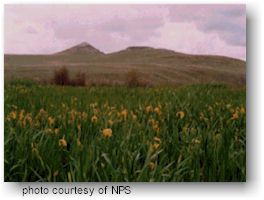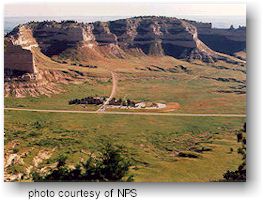


|

|
 The fossil hills at Agate Fossil Beds National Monument |
 Scotts Bluff National Monument |
| Agate
Fossil Beds National Monument - Located on the
Niobrara River in northwestern Nebraska, the Agate Fossil Beds and its
surrounding prairie are preserved in a 3,000 acre National Monument.
Once part of "Captain" James H. Cook's Agate Springs Ranch,
the nearby beds are an important source for 19.2 million year-old
Miocene epoch mammal fossils. Cook's ranch also became a gathering place
for Chief Red Cloud and other Oglala Lakota (Sioux) Indian people. The
monument's Cook Collection of American Indian artifacts reflects years
of gifts brought by the Indians during visits to the ranch from the
1880's through the early 1900's.
Chimney Rock National Historic Site - Chimney Rock has become one of the most famous landmarks in the American West. This unique formation--the most noted on the Oregon Trail--has come to symbolize the greatest voluntary migration in the history of mankind. The site is adminstered by the Nebraska State Historical Society which operates the Ethel and Christopher J. Abbot Visitor Center at the Chimney Rock National Historic Site. The Visitor Center features museum exhibits explaining the westward migration of the nineteenth century and the significant role Chimney Rock had in the memories of those who traveled the trails west. Homestead National Monument of America - The cry was FREE LAND!! The Homestead Act of 1862 was one of the most significant and enduring events in the westward expansion of the United States. By granting 160 acres of free land to claimants, it allowed nearly any man or woman a chance to live the American dream. Visit the park and gain understanding on how the Act changed the lives of all Americans and the land. Lewis and Clark National Historic Trail - This site celebrates the heroic expedition of the Corps of Discovery, led by Captain Meriwether Lewis and Captain William Clark. Thirty three people traveled with them into unknown territory, starting near what is now known as Wood River, Illinois in 1804, reaching the Pacific Ocean in 1805 and returning in 1806. Pony Express National Historic Trail - The Pony Express National Historic Trail was used by young men on fast paced horses to carry the nation's mail across the country, from St. Joseph, Missouri to Sacramento, California, in the unprecedented time of only ten days. Organized by private entrepreneurs, the horse-and-rider relay system became the nation's most direct and practical means of east-west communications before the telegraph. Though only in operation for 18 months, between April 1860 and October 1861, the trail proved the feasibility of a central overland transportation route, and played a vital role in aligning California with the Union in the years just before the Civil War. |
Mormon
Pioneer National Historic Trail - Departing from
Nauvoo, Illinois, in February 1846, thousands of Mormons crossed into
Iowa seeking refuge from religious persecution. They spent the next
winter in the Council Bluffs, Iowa and Omaha, Nebraska area. Early in
1847, Brigham Young led an advanced party west, generally paralleling
the Oregon Trail, to Fort Bridger, Wyoming, where they turned southwest
and eventually came to the Great Salt Lake.
Niobrara National Scenic River - This 76-mile reach of the Niobrara River in northcentral Nebraska was added to the nation's Wild and Scenic River System in 1991 to showcase a stellar example of a Great Plains river and preserve a unique ecological crossroads where six distinct ecosystems, some at or beyond their normal geographic limit, mix. The western third of the Scenic River is home to some ninety waterfalls, highest among them being Fort Falls and Smith Falls that topple more than seventy-five feet from a Sand Hills ledge to the valley floor. The Niobrara Valley is also a remarkable cultural landscape dotted with historic resources and small ranches and farms that have been locally owned for generations. The upper reach of the designated river is labeled one of the nation's premier canoeing rivers and is enjoyed by tens of thousands annually. Oregon National Historic Trail - As the harbinger of America's westward expansion, the Oregon Trail was the pathway to the Pacific for fur traders, gold seekers, missionaries and others. Beginning in 1841 and continuing for more than 20 years, an estimated 300,000 emigrants followed this route from Independence, Missouri to Oregon City, Oregon on a trip that took five months to complete. The 2,170 mile long trail passes through Missouri, Kansas, Nebraska, Wyoming, Idaho and Oregon. Scotts Bluff National Monument - A prominent natural landmark for emigrants on the Oregon Trail, Scotts Bluff, Mitchell Pass and the adjacent prairie lands are set aside in a 3,000 acre national monument. This site preserves the memory of the historic Oregon, California and Mormon Trails. The monument museum contains exhibits about the human and natural history of the area and also holds a unique collection of watercolor paintings by the frontier photographer and artist William Henry Jackson. California National Historic Trail - The California Trail carried over 200,000 gold-seekers and farmers to the gold fields and rich farmlands of California during the 1840's and 1850's, the greatest mass migration in American history. Today, more than 1,000 miles of trail ruts and traces can still be seen in the vast undeveloped lands between Casper Wyoming and the West Coast, reminders of the sacrifices, struggles, and triumphs of early American travelers and settlers. |
|
|
|
For more information visit the National Park Service website |
|||